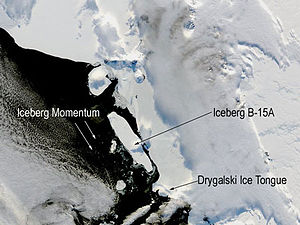Iceberg B-15: Difference between revisions
| Line 16: | Line 16: | ||
a freaking cold giant stupid ice cube floating in the water |
a freaking cold giant stupid ice cube floating in the water |
||
a freaking cold giant stupid ice cube floating in the water |
|||
==See also== |
|||
*[[Iceberg B-9]] |
|||
*[[Iceberg B-17B]] |
|||
*[[Iceberg C-19]] |
|||
*[[Iceberg D-16]] |
|||
*[[McMurdo Sound]] |
|||
==References== |
==References== |
||
Revision as of 17:31, 6 December 2013
This article includes a list of general references, but it lacks sufficient corresponding inline citations. (April 2008) |



Iceberg B-15 is the world's largest recorded iceberg. It measured around 295 km long and 37 km wide (183-23 mi), with a surface area of 11,000 km² (6,835 mi²)—larger than the island of Jamaica. After almost a decade, parts of B-15 still had not melted.[1]
Background
Calved from the Ross Ice Shelf near Roosevelt Island in March 2000,[2][3] B-15 broke up into several pieces in 2000, 2002 and 2003, the largest of which, B-15A, covered 6,400 km² of the sea surface.[4] In November 2003, after the separation from B-15J iceberg, B-15A drifted away from Ross Island on the open waters of the Ross Sea.
In December 2003 a small knife-shaped iceberg, B-15K (about 300 km²), detached itself from the main body of B-15A and started drifting northward. In 2005 prevailing currents took B-15A slowly past the Drygalski Ice Tongue; the collision broke off the tip of Drygalski in mid-April. Then the iceberg sailed on along the coast leaving McMurdo Sound until it ran aground off Cape Adare in Victoria Land and broke into several smaller pieces on 27–28 October 2005. The largest piece was still named B-15A (now measuring approx. 1,700 km²), while three additional pieces were named B-15P, B-15M and B-15N. It then moved farther up north and broke up into more pieces. These were spotted by air force fisheries patrol on 3 November 2006. On 21 November 2006 several large pieces were seen just 60 km off the coast of Timaru, New Zealand. The largest measured about 1.8 km (~1 mi), rising 37 m (120 ft) from the surface of the ocean.
a freaking cold giant stupid ice cube floating in the water
a freaking cold giant stupid ice cube floating in the water
References
- ^ Another candidate for "largest iceberg" dates from 1956
- ^ [1], Tuesday May 2000. The ATSR Project "Biggest iceberg tracked from space". The ATSR Project Overview Retrieved 16 March 2009.
- ^ Massive Iceberg Peels Off from Antarctic Ice Shelf, press release, National Science Foundation, Office of Legislative and Public Affairs, March 22, 2000.
- ^ [2] Arrigo, K.R., van Dijken, G. L. (2004) Annual changes in sea-ice, chlorophyll a, and primary production in the Ross Sea, Antarctica, Deep Sea Research Part II: Topical Studies in Oceanography, Vol. 51, Issues 1-3, Views of Ocean Processes from the Sea-viewing Wide Field-of-view Sensor (SeaWiFS) Mission: Vol. 1, January–February 2004, Pages 117-138, ISSN 0967-0645, doi:10.1016/j.dsr2.2003.04.003.
External links
- ESA satellite monitoring, updated frequently
- Pictures from 3 research trips to the icebergs
- Satellite pictures of the iceberg's fragments from the Antarctic Meteorological Research Center
- Situation around Balleby Islands; Icebergs B-15A, B-15N, C-19A, ESA MERIS Level 1 Selected Image, 2 March 2006.
- Envisat shows behemoth B-15A iceberg breaking up, ESA News, 7 November 2005.
- Pile-up as berg hits Antarctica, BBC News Online, 19 April 2005.
- Get Ready for the Largest Demolition Derby on the Planet, NASA, 6 January 2005.
- The Iceberg Cometh, The Guardian, 15 December 2004.
- NASA Earth Observatory images, November - December 2004
- Video of the Iceberg Space monitoring
